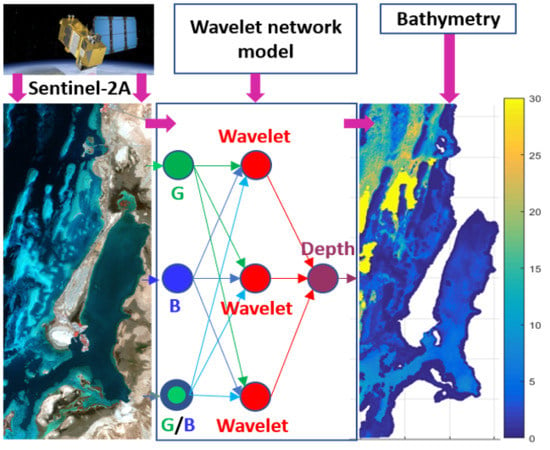Satellite-Based Bathymetric Modeling Using a Wavelet Network Model
Abstract
:1. Introduction
2. Traditional Satellite-Derived Bathymetric Linear Modeling
3. Wavelet Network Model
4. Data Description and Methodology
5. Results and Discussion
6. Conclusions and Recommendations
Funding
Acknowledgments
Conflicts of Interest
References
- Stumpf, R.; Holdried, K.; Sinclair, M. Determination of Water Depth with High-Resolution Satellite Imagery Over Variable Bottom Types. Limnol. Oceanogr. 2003, 48, 547–556. [Google Scholar] [CrossRef]
- Liu, S.; Wang, L.; Liu, H.; Su, H.; Li, X.; Zheng, W. Deriving Bathymetry from Optical Images with a Localized Neural Network Algorithm. IEEE Trans. Geosci. Remote Sens. 2018, 56, 5334–5342. [Google Scholar] [CrossRef]
- McIntyre, M.; Naar, D.; Carder, K.; Donahue, B.; Mallinson, D. Coastal bathymetry from hyperspectral remote sensing data: Comparisons with high resolution multibeam bathymetry. Mar. Geophys. Res. 2006, 27, 129–136. [Google Scholar] [CrossRef]
- Giardino, C.; Candiani, G.; Bresciani, M.; Lee, Z.; Gagliano, S.; Pepe, M.; Bomber, A. A tool for estimating water quality and bottom properties from remote sensing images. Comput. Geosci. 2012, 45, 313–318. [Google Scholar] [CrossRef]
- Hamylton, S.M.; Hedley, J.D.; Beaman, R.J. Derivation of high-resolution bathymetry from multispectral satellite imagery: A comparison of empirical and optimisation methods through geographical error analysis. Remote Sens. 2015, 7, 16257–16273. [Google Scholar] [CrossRef]
- Setiawan, K.T.; Adawiah, S.W.; Marini, Y.; Winarso, G. Bathymetry Data Extraction Analysis Using Landsat 8 Data. Int. J. Remote Sens. Earth Sci. 2016, 13, 79–86. [Google Scholar] [CrossRef]
- Eugenio, F.; Marcello, J.; Martin, J.; Rodríguez-Esparragón, J.G. Benthic Habitat Mapping Using Multispectral High-Resolution Imagery: Evaluation of Shallow Water Atmospheric Correction Techniques. Sensors 2017, 17, 2639. [Google Scholar] [CrossRef] [PubMed]
- Traganos, D.; Poursanidis, D.; Aggarwal, B.; Chrysoulakis, N.; Reinartz, P. Estimating Satellite-Derived Bathymetry (SDB) with the Google Earth Engine and Sentinel-2. Remote Sens. 2018, 10, 859. [Google Scholar] [CrossRef]
- Casal, G.; Monteys, X.; Hedley, J.; Harris, P.; Cahalane, C.; McCarthy, T. Assessment of empirical algorithms for bathymetry extraction using Sentinel-2 data. Int. J. Remote Sens. 2019, 40, 2855–2879. [Google Scholar] [CrossRef]
- Lyzenga, D.R. Shallow-water bathymetry using combined LIDAR and passive multispectral scanner data. Int. J. Remote Sens. 1985, 6, 115–125. [Google Scholar] [CrossRef]
- Lyzenga, D.; Malinas, N.; Tanis, F. Multispectral bathymetry using a simple physically based algorithm. IEEE Trans. Geosci. Remote Sens. 2006, 44, 2251–2259. [Google Scholar] [CrossRef]
- Zhang, Q. Using Wavelet Network in Nonparametric Estimation. IEEE Trans. Neural Netw. 1997, 8, 227–236. [Google Scholar] [CrossRef] [PubMed]
- Adeli, H.; Samant, A. An adaptive conjugate gradient neural network-wavelet model for traffic incident detection. Comput. Aided Civ. Infrastruct. Eng. 2000, 15, 251–260. [Google Scholar] [CrossRef]
- El-Diasty, M.; Al-Harbi, S. Development of wavelet network model for accurate water levels prediction with meteorological effects. Appl. Ocean Res. 2015, 53, 228–235. [Google Scholar] [CrossRef]
- Zhang, Q.; Benveniste, A. Wavelet networks. IEEE Trans. Neural Netw. 1992, 3, 889–898. [Google Scholar] [CrossRef] [PubMed]
- Oussar, Y.; Rivals, I.; Personnaz, L.; Dereyfus, G. Training wavelet networks for nonlinear dynamic input-output modeling. Neurocomputing 1998, 20, 173–188. [Google Scholar] [CrossRef]
- El-Diasty, M.; El-Rabbany, A.; Pagiatakis, S. An Accurate Nonlinear Stochastic Model for MEMS-Based Inertial Sensor Error with Wavelet Networks. J. Appl. Geod. 2007, 1, 201–212. [Google Scholar] [CrossRef]
- Haykin, S. Neural Networks and Learning Machines, 3rd ed.; Pearson Prentice Hall: Upper Saddle River, NJ, USA, 2009. [Google Scholar]
- Andrew, W.; Donald, P. Wavelet Methods for Times Series Analysis; Cambridge University Press: Cambridge, UK, 2000. [Google Scholar]
- Copernicus Open Access Hub (COAH). Available online: https://scihub.copernicus.eu/dhus/#/home (accessed on 1 January 2019).
- Sentinel Application Platform (SNAP). Available online: http://step.esa.int/main/toolboxes/snap/ (accessed on 1 January 2019).
- Louis, J.; Debaecker, V.; Pflug, B.; Main-Knorn, M.; Bieniarz, J.; Mueller-Wilm, U.; Cadau, E.; Gascon, F. SENTINEL-2 SEN2COR: L2A Processor for Users. In Proceedings of the Living Planet Symposium, Prague, Czech Republic, 9–13 May 2016; Volume SP-740, pp. 1–8. [Google Scholar]
- McFeeters, S.K. The use of the Normalized Difference Water Index (NDWI) in the delineation of open water features. Int. J. Remote Sens. 1996, 17, 1425–1432. [Google Scholar] [CrossRef]
- MATLAB 2016; The Math Works, Inc.: Natick, MA, USA, 2016.
- International Hydrographic Bureau (IHO). IHO Standards for Hydrographic Surveys, 5th ed.; International Hydrographic Bureau (IHO): Monaco, the Principality of Monaco, 2008. [Google Scholar]













| Model | Stumpf Log-Ratio Model | ANN Model | Wavelet Network Model |
|---|---|---|---|
| Correlation Coefficient for the Models | |||
| Modeling correlation (50 stations) | 89% | 93% | 97% |
| Validation correlation (40 stations) | 89% | 91% | 93% |
| Overall correlation (90 stations) | 89% | 92% | 95% |
| RMS Error for the Models | |||
| Modeling RMS error (50 stations) | 3.26 m | 2.53 | 1.93 |
| Validation RMS error (40 stations) | 2.13 m | 1.76 | 1.55 |
| Overall RMS error (90 stations) | 2.91 m | 2.30 | 1.82 |
| Survey Order | a | b | Maximum Allowable TVU with 15 m Average Depth. |
|---|---|---|---|
| Special | 0.25 | 0.0075 | 0.27 |
| 1a | 0.5 | 0.013 | 0.54 |
| 1b | 0.5 | 0.013 | 0.54 |
| 2 | 1 | 0.023 | 1.06 |
© 2019 by the author. Licensee MDPI, Basel, Switzerland. This article is an open access article distributed under the terms and conditions of the Creative Commons Attribution (CC BY) license (http://creativecommons.org/licenses/by/4.0/).
Share and Cite
El-Diasty, M. Satellite-Based Bathymetric Modeling Using a Wavelet Network Model. ISPRS Int. J. Geo-Inf. 2019, 8, 405. https://0-doi-org.brum.beds.ac.uk/10.3390/ijgi8090405
El-Diasty M. Satellite-Based Bathymetric Modeling Using a Wavelet Network Model. ISPRS International Journal of Geo-Information. 2019; 8(9):405. https://0-doi-org.brum.beds.ac.uk/10.3390/ijgi8090405
Chicago/Turabian StyleEl-Diasty, Mohammed. 2019. "Satellite-Based Bathymetric Modeling Using a Wavelet Network Model" ISPRS International Journal of Geo-Information 8, no. 9: 405. https://0-doi-org.brum.beds.ac.uk/10.3390/ijgi8090405






